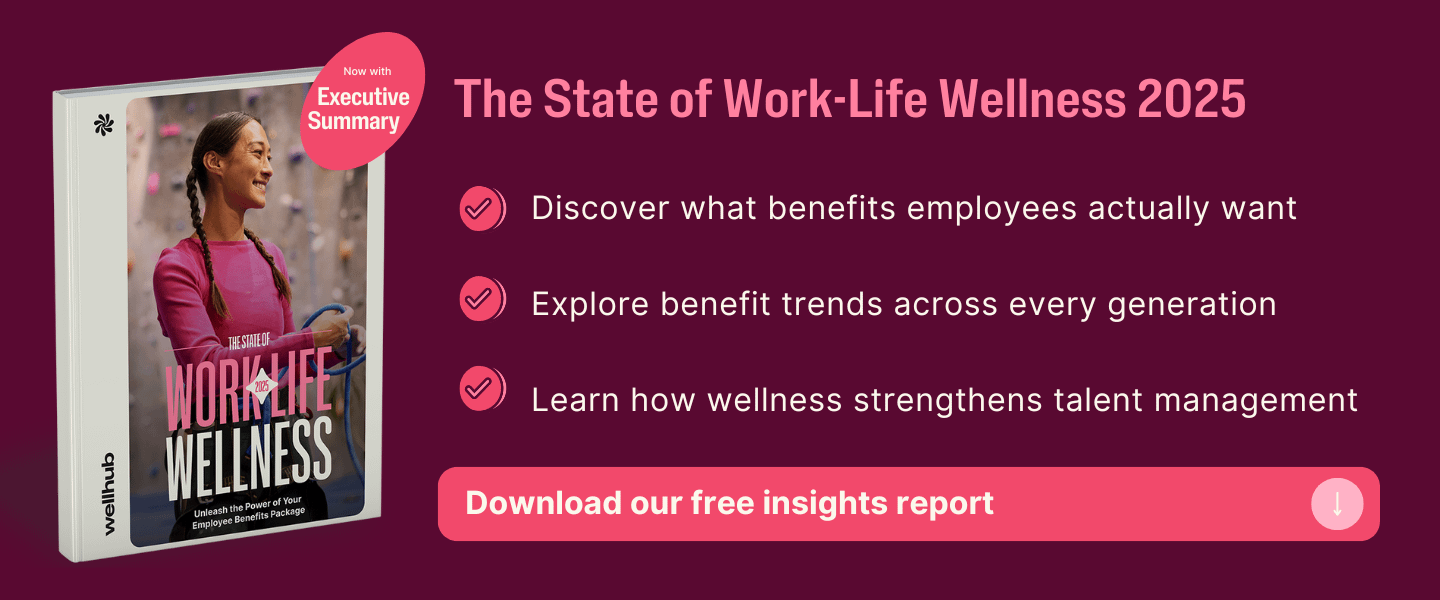How to Maximize the Impact of Your Employee Benefits Package
Last Updated Jan 28, 2025

Gone are the days when a paycheck was enough to keep an employee engaged and productive. Today's workforce expects a robust benefits package that echoes their comprehensive needs and aspirations, not just competitive salaries and health insurance.
Of course, however, HR budgets aren't unlimited. Forty-five percent of companies of every size say offering a competitive benefit package was their primary struggle in 2023. At the same time, the cost of offering these benefits and addressing claims is also rising — along with employee expectations and workforce diversity.
As Wellhub’s Chief People Officer, this is a challenge with which I am very familiar. Caring deeply that our talent feels and does their best work is why we do what we do after all! But in the world of real budget constraints, we need every benefit dollar to work as hard as we do.
This is why Wellhub set out to identify what employees expect from their benefit packages through an international survey of more than 5,000 full-time employees. We found out where companies are missing the mark, as well as how they can better meet staff expectations — and we are revealing everything in our State of Work-Life Wellness 2025 report, out today.
Here's what we discovered about nailing the right strategic mix of benefits so your department can make the best possible contribution to your organization.
Key Finding 1: Employees Expect Employers to Deliver Workforce Wellness
Employees are looking for a company culture and benefits package that supports their wellness. This resounding demand for personal wellbeing means competitive pay alone won’t pull top talent in the door. Companies have to fulfill the quality-of-life promises they make during recruitment or risk employees quickly seeking opportunities elsewhere.
What We Found:
- 83% of employees would consider leaving a company that does not focus on employee wellbeing.
- 85% of workers believe their employer has a responsibility to help them tend to their wellbeing.
- 88% of employees value their wellbeing at work just as much as their salary.
- 89% of workers only consider employers that place a clear emphasis on employee wellbeing.
The Takeaway: Meeting these expectations is non-negotiable if you expect anyone but AI to work for you. Companies that don’t meet their workers’ needs are going to pay the price in high recruiting fees and rising re-staffing costs.
Key Finding 2: Employees are Struggling
There is a striking disconnect between how employees describe their wellbeing and the reality beneath the surface. While 63% of workers confidently describe their overall wellbeing as "good" or "thriving," the underlying numbers tell a very different story.
What We Found:
- Fitness: Only 54% of employees consider themselves physically fit.
- Mental Wellness: Nearly half (47%) admit that work stress is taking a toll on their mental health.
- Nutrition: Just 40% claim their diet is healthy or extremely healthy.
- Sleep: An overwhelming 71% of workers report getting less than the recommended seven hours of sleep each night.
- Finances: 68% of employees say that financial constraints prevent them from investing in their health.
The Takeaway: Employers are falling short of employee wellbeing expectations, indicating wellness must become a higher priority for HR leaders and their organizations.

Key Finding 3: Demand for Workforce Wellbeing is Growing
The demand for more wellbeing support is loud and clear across the entire workforce, and the call for wellness is getting even louder over time. Millennials — the largest generation in the workforce — and Gen Z — the largest generation in the world — are even more likely than previous generations to demand wellbeing.
What We Found:
Gen Z and Millennials are more likely than Gen X or Baby Boomers to say:
- Their wellbeing is as important as their salary.
- They would leave an employer who doesn't emphasize employee wellbeing.
- They would only consider working for employers that support employee wellness.
The Takeaway: As these two generations will be the bulk of your employees for the foreseeable future, it is increasingly critical for HR to meet workforce wellness expectations.
Key Finding 4: Wellbeing Supports Boost Employee Wellbeing
This desire for workforce wellness isn’t just about being nice to employees — workers want wellness benefits because they truly improve their quality of life. Offering a workforce wellness program boosts employee wellbeing across the board.
What We Found:
Employees with wellbeing programs have higher wellbeing than those without and are more likely to say their wellbeing improved over the last year. They are also more likely to report positive:
- Overall wellbeing compared (69% of workers with wellness program vs. 53% of employees without)
- Mental wellbeing (63% vs. 48%)
- Physical wellbeing (60% vs. 45%)
- Nutritional health (47% vs. 29%)
- Fitness health (47% vs. 27%)
- Sleep health (39% vs. 21%)
The Takeaway: Offering a wellbeing program is a distinct competitive advantage as employee wellbeing is directly tied to employee performance and productivity.
Better Benefits, Better Business
Prioritizing employee wellbeing creates a sustainable work environment that attracts and retains talent across all age groups. As the workforce evolves, so must our approach to wellness, recognizing it as a universal need and a key driver of organizational success.
Fortunately, bolstering your wellbeing benefits to meet these expectations isn’t a benefit expansion that’s going to strain your budget. In fact, it might even expand it as the majority of companies see a return of at least $2 for every $1 they invest in their employee wellbeing program.
This is why Wellhub is on a mission to make every company a wellness company. We know that prioritizing employee wellness isn’t just compassionate — it’s smart business.
For more detailed insights and actionable strategies you can use to implement effective wellness programs, download the full State of Work-Life Wellness 2025 report today.
Category
Share

Livia Martini is the Chief People Officer at Wellhub, having joined the team in 2017 initially as the Head of International Operations. In her current role as CPO, she oversees a global team of over 2,000 employees across 18 countries. Livia is responsible for creating an exceptional working environment at Wellhub, leveraging a wealth of experience in people management and financial operations. She has a lifelong passion for tennis and has recently found joy in running and cycling.
Subscribe
Our weekly newsletter is your source of education and inspiration to help you create a corporate wellness program that actually matters.
Subscribe
Our weekly newsletter is your source of education and inspiration to help you create a corporate wellness program that actually matters.
You May Also Like

Corporate Wellness Trends HR Must Know for 2026 | Wellhub
See the top 2026 wellness trends shaping performance, retention, and culture—plus how HR can build a unified, ROI-driven wellbeing strategy.

Wellness Points Programs: Boost Employee Health & Engagement | Wellhub
Turn your workplace wellness strategy around with a points program that rewards healthy behavior with perks, from extra time off to gift cards.

Employee Financial Wellness Programs: Ultimate HR Guide | Wellhub
Create an effective financial wellness program that supports your employees in their financial needs, boosting productivity and retention.